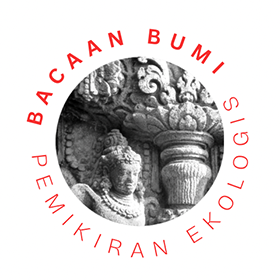A semiotic analysis of Pramoedya Ananta Toer in digital culture
Nazarudin
Pramoedya Ananta Toer stands as a major figure in the landscape of Indonesian history and literature. His life and works are deeply intertwined with the intense periods of Dutch colonialism, the Indonesian struggle for independence, the Japanese occupation, and the subsequent authoritarian regimes. His literary contributions, including the internationally acclaimed Buru Quartet, offer profound insights into Indonesian society, nationalism, and the human condition. Despite facing censorship and imprisonment for his political views, Pramoedya's legacy as a champion of freedom of expression and a critical voice against injustice endures.
In the contemporary digital age, the image and legacy of historical figures are often recontextualised and disseminated through internet memes. These digital artifacts, characterised by their blend of visual and textual elements, circulate widely across online platforms, often undergoing transformation and adaptation by numerous users. The phenomenon of ‘meme-ification’ raises intriguing questions about how historical memory is constructed, negotiated, and experienced by new generations in the digital sphere. This report aims to explore this intersection by examining the semiotic representation of Pramoedya Ananta Toer in internet memes. Sites like Wikipedia define internet memes very broadly as images, hyperlinks, plain text, etc. Memes are not always necessarily funny. By analysing the visual and textual signs within these memes, this article seeks to understand the multifaceted ways in which Pramoedya's image and legacy are being engaged with, interpreted, and potentially reshaped in digital culture.
The semiotics of memes provides the foundational tools for analysing how meaning is constructed within these digital artifacts. Semiotics, the study of signs and symbols and their interpretation, offers a lens through which to examine the visual and verbal elements of memes and the cultural codes they draw upon. Key figures in semiotics, such as Roland Barthes and Charles Sanders Peirce, offer valuable models for deconstructing the layers of meaning embedded in memes. Additionally, the study of the visual representation of historical figures in internet culture provides a specific lens to figure out how Pramoedya Ananta Toer is portrayed.
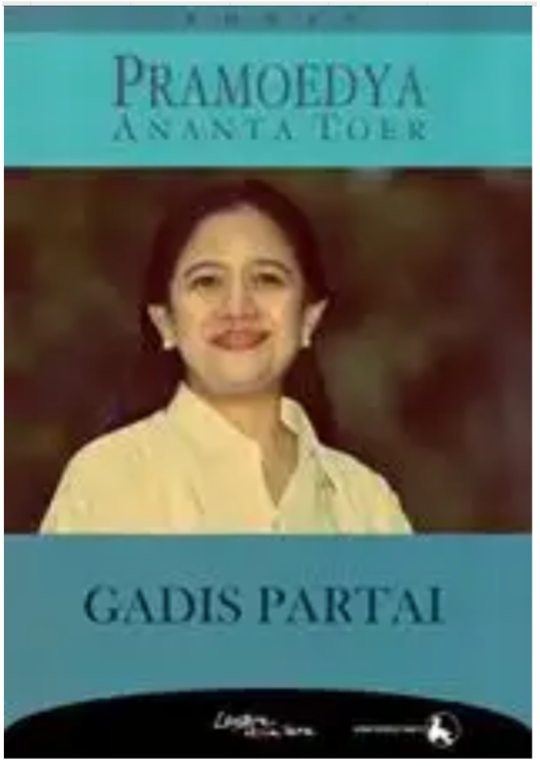
Internet memes contribute to the ongoing process of shaping and reshaping public perception of historical figures, often through processes of simplification, humorisation, or politicisation, such as the example in Figure 1 derived from the title of Pram’s book Gadis Pantai. In Figure 1, the meme creator uses the sound similarities between the words /pantai/ and /partai/. Based on the data, we can categorise at least three kinds of representations of Pram in the digital world - the serious intellectual, the satirical figure, and the political symbol, which we will discuss further.
The serious intellectual, the satirical figure and the political symbol
A significant category of Pramoedya Ananta Toer memes feature formal portraits of the author, often accompanied by scholarly captions or quotes taken from his books. Figure 2 was posted in celebration of Pram’s birthday on anotasi.org.
In this meme, key visual signifiers play a crucial role in constructing the image of a serious intellectual. The presence of glasses, frequently depicted in these portraits, often signifies intellect, knowledge, and a studious nature. Pramoedya's stern expression, another recurring visual element, connotes seriousness, deep thought, and authority. Additionally, the quotes written in the meme, which are taken from his book Bumi Manusia, act as indexical signs, directly pointing to his substantial intellectual output.
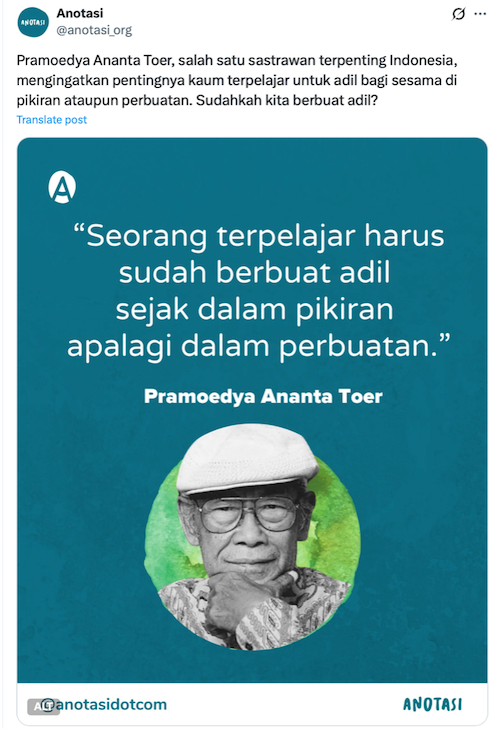
The meanings conveyed through these signifiers reinforce Pramoedya's image as a figure of wisdom, authority, intellectual prowess, and historical significance. They also preserve and solidify his legacy as a respected intellectual figure within Indonesian history and literature. The use of formal portraits such as in Figures 2 and 3 and attributed quotes lends gravitas, positioning him as a source of knowledge and insight. Memes portraying Pramoedya in this manner may serve as an entry point for younger audiences to learn about his importance as a thinker and writer, functioning as a form of digital commemoration. By highlighting his intellectual contributions and establishing him as an authority in his field, these memes contribute to the digital preservation of his scholarly image.
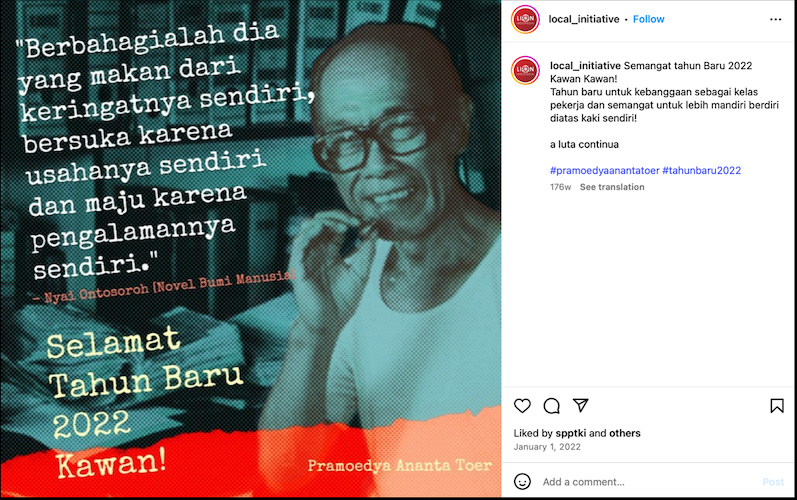
Another notable category of Pramoedya Ananta Toer memes is at times seen in absurd or humorous edits of his images. The signified meanings derived from these satirical memes, such as in Figure 4, often revolve around humour and irony, sometimes offering commentary on contemporary culture through Pramoedya's quotes. This meme can generate amusement and potentially make Pramoedya's quote more approachable to broader audiences. The meme in Figure 4 is a reference to a well-known incident on social media involving a prominent ulama (he is also part of the Presidential staff) and an iced tea seller, in a Muslim sermon. In that sermon the ulama mocked the iced tea seller. The video went viral, the ulama was widely condemned.
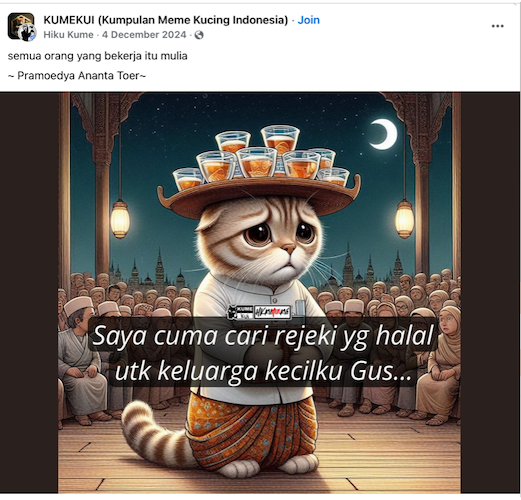
These satirical representations reflect the broader trend of remixing culture within digital spaces, where historical figures and cultural artefacts are frequently adapted and reinterpreted in new and often unexpected ways. Satirical touches of humour can lower the barrier to entry for those unfamiliar with Pramoedya, potentially sparking curiosity even if it initially presents a simplified or comedic view of his persona as exemplified in Figure 5 taken from the social media posts of Dewan Kesepian Jakarta (Jakarta Loneliness Council).
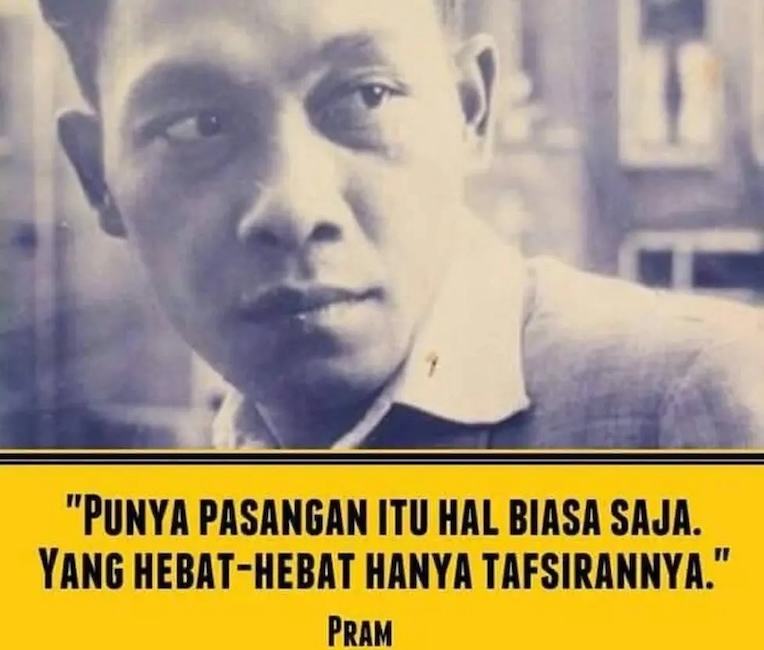
This meme from the Jakarta Loneliness Council came about as a form of resistance to the social pressure to get married. The translation of the quote is, ‘Having a date is nothing special; what makes it great is only the interpretation of it'; altering the famous Pramoedya Ananta Toer quote, ‘Life is simple; what makes it complicated are interpretations of it.’ The photo used in this meme is one of Pram when he was young. This becomes an index of the audience targeted through this meme, namely the younger generation.
A third significant category of Pramoedya Ananta Toer memes invokes his anti-authoritarian legacy, often used in socio-political jokes about censorship, neoliberalism or current Indonesian politics. The signifiers in these memes include images of Pramoedya associated with his periods of resistance, such as during his imprisonment, as well as quotes reflecting his political views in juxtapositions with references to contemporary socio-political issues, as exemplified in Figure 6.
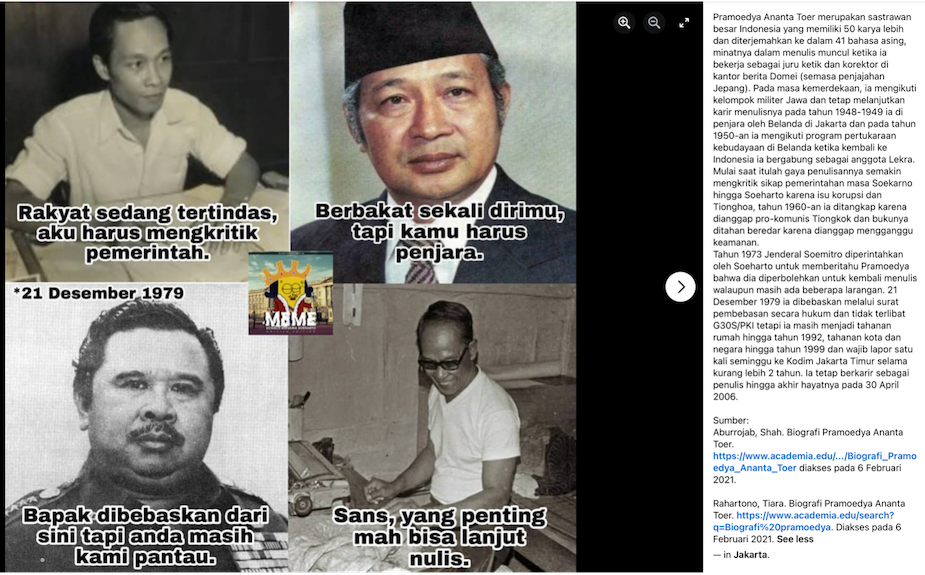
Three figures appear in the meme, namely Pram, Suharto, and Soemitro. In this meme Pram appears in two representations, young Pram and middle-aged Pram. Young Pram is shown as a progressive figure bravely criticising the government (Sukarno to Suharto) until his arrest in the Suharto era. Under General Soemitro, Pram was released from detention but put under house arrest. In the meme the middle-aged Pram says in today's Jakarta slang, ‘Sans, yang penting mah bisa lanjut nulis’ (Just chill, the most important thing is I can continue writing).
The signified meanings in these memes centre on themes of resistance against oppression, critique of political systems, and the invocation of historical parallels between Pramoedya's struggles and current events. These memes effectively utilise Pramoedya Ananta Toer as a potent symbol for contemporary socio-political commentary, drawing upon his well-known stance against authoritarianism and his experiences with censorship. The use of historical figures in memes to draw parallels with current situations and express political opinions is a common practice in digital culture.
The multifaceted meanings of Pramoedya memes
The semiotic analysis of Pramoedya Ananta Toer memes reveals a dual dynamic at play. While some memes reinforce his established legacy as a serious intellectual through the use of formal portraits and scholarly references, others subvert this image through humour and satire, potentially making him more accessible to younger audiences but also risking the trivialisation of his contributions. This duality highlights the complex ways in which historical figures are negotiated and understood in digital spaces.
Furthermore, Pramoedya's image is being used for specific political agendas within meme culture. Memes invoking his anti-authoritarian stance suggest a desire to connect his historical struggles with contemporary political issues in Indonesia, positioning him as a symbol of resistance against various forms of oppression. This political instrumentalisation raises ethical considerations regarding the use of historical figures for present-day commentary, particularly if it oversimplifies or misrepresents their original context.
The question of a generational divide in engagement with Pramoedya's legacy also emerges. It is plausible that younger Indonesians, who have grown up in the digital age, primarily encounter and interact with Pramoedya through memes. This mode of engagement could have significant implications for their understanding of his work in its original, often complex, historical and literary context. The interpretation and appreciation of Pramoedya's nuanced literary contributions might differ significantly between those familiar with his novels and those whose primary exposure comes through the condensed and often humorous format of internet memes.
The centenary commemoration of Pramoedya Ananta Toer's birth in 2025, marked by the hashtag #SeabadPram, provides a crucial temporal context for understanding the creation and circulation of memes related to him. The official events and discourse surrounding this commemoration may intersect with or be reflected in meme culture, potentially leading to a surge in Pramoedya-related memes as a form of public engagement with his life and works. This centenary offers a unique opportunity to study the interplay between official memory initiatives and the spontaneous, often irreverent, expressions of digital folklore.
Celebrating Pram’s centenary in the digital age
The centenary of renowned Indonesian author Pramoedya Ananta Toer sparked a vibrant digital celebration, prominently featuring the hashtag #seabadpram across major social media platforms like Instagram, Threads, X (formerly Twitter), and Facebook. This online outpouring of remembrance went beyond simple acknowledgment, showcasing the enduring impact of Pramoedya's literary legacy.
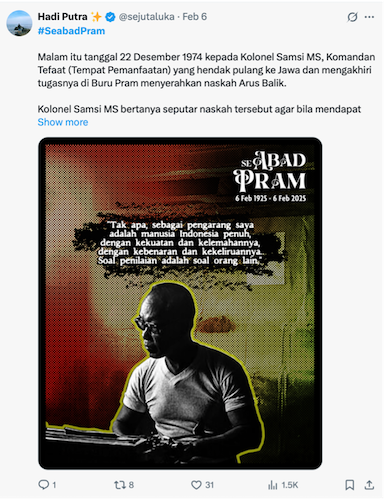
The nature of the posts varied, reflecting the diverse ways individuals connect with Pramoedya's work. Many users shared heartfelt greetings and tributes, acknowledging his profound influence on Indonesian literature and thought. More significantly, a substantial number of posts featured quotes from Pramoedya's vast body of work, carefully selected for their relevance to current phenomena. This act of sharing not only introduced his powerful prose to a wider audience but also demonstrated how his timeless observations on humanity, justice, and societal struggles continue to resonate with contemporary issues in Indonesia.
Pramoedya in the digital mirror
The semiotic analysis of internet memes featuring Pramoedya Ananta Toer reveals a complex and multifaceted engagement with his image and legacy in digital culture. Across the case studies, memes portray him as a serious intellectual, a satirical figure and a political symbol, highlighting different aspects of his significance in Indonesian history and literature.
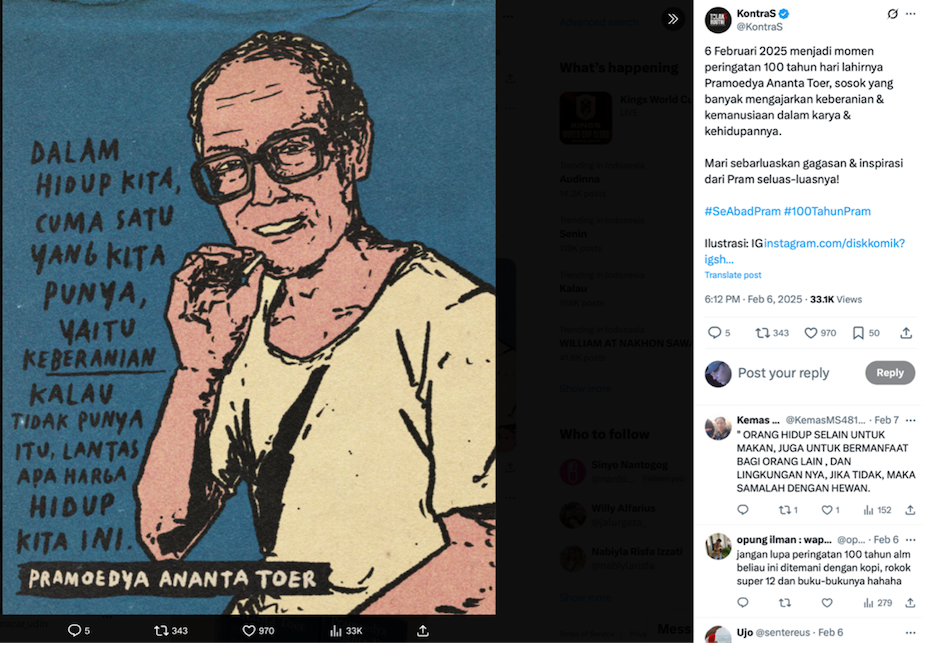
This shows us that digital platforms and internet culture are reshaping the ways in which historical figures are remembered, interpreted, and transmitted. Internet memes serve as a contemporary form of collective memory-making, offering a space for both the reinforcement and subversion of established narratives. While some memes contribute to preserving Pramoedya's intellectual authority, others use humour and satire to recontextualise him for new audiences. Furthermore, his image is actively employed for socio-political commentary, connecting his historical struggles with current issues in Indonesia. The potential for both democratisation and distortion of historical narratives through memes underscores the need for critical engagement with these digital representations. The ‘Seabad Pram’ commemoration in 2025 provides a timely opportunity to further observe and analyse how official memory intersects with the dynamic and evolving landscape of digital folklore surrounding this iconic Indonesian figure.
Nazarudin is a lecturer of Indonesian Studies Program, Faculty of Humanities at the University of Indonesia.












